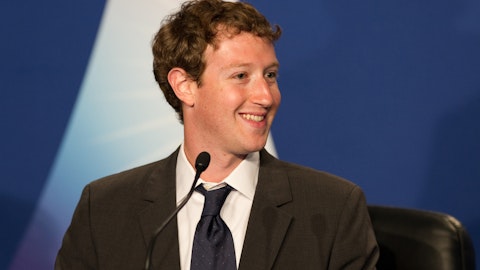Javier Olivan: So on the advertisers reaction to Reels. We continue working on enabling more advertisers to participate in Reels app, more formats, more objectives, more tools to create them. And we’ve been making good progress with now over 40% of our advertisers use Reels across our apps. And between Direct Response versus brand, we are actually seeing progress with both, but Direct Response continues to be where advertisers are focused. And just as an example, Outletcity, which is a German fashion retailer, developed €“ created specifically for Reels to test the impact of conversions. And they found that Reels resulted in a 19x higher ROIs, 89% lower cost per purchase, and 9x higher lift in sales. So overall, very good results.
Susan Li: On your third question, Eric, we are not quantifying the gap in monetization efficiency between Reels and other services. We know it took us several years to bring the gap close between Stories and Feed Ads. And we expect that this will take longer for Reels. Having said that, we are still roughly on track to bring the overall Reels revenue headwind to a neutral place by the end of this year or early next year and we are planning to do that through both improving Reels monetization efficiency and growing incremental engagement from Reels.
Operator: Your next question comes from the line of Mark Shmulik with Bernstein. Your line is open.
Mark Shmulik: Yes. Thanks for taking the questions. I’ve got a couple as well. First one, I know for Susan or Javier. As we think about €“ I appreciate the color on improving conversion rate. Would it be fair to say that you’re kind of through the other side of some of those IDFA headwinds we’ve been talking about for the last year or so? And any more color just kind of that journey of the AI-driven adage would be appreciated. And secondly, Mark, kind of diving in that annual theme of efficiency and following on Buzz’s post. What’s the right way to think about long-term investment intensity in Reality Labs and kind of balancing that with the ambition to build the next computing platform. Is this the right intensity of kind of where you’re at right now to think about? Or are there any milestones we should be looking for? Thanks.
Susan Li: Thanks Mark. So on your first question, we are continuing to make progress in mitigating the impact from the ATT change. But this is more generally just the reality of the online advertising environment that we operate in now. So we’re continuing to work on building tools that mitigate the impact of those changes, and we see strong adoption of those tools, including tools we’ve talked about before like CAPI Gateway, etcetera. We’re also investing in ways to bring conversions on site, and we have a lot of ad formats that have been instrumental in doing so across both click-to-messaging ads, leads ads €“ lead ads and shop adds being formats that bring conversions on site. And then over the longer run, we’re continuing to invest in our privacy-enhancing technologies to more fundamentally enable us to deliver more performance and privacy-safe ads to advertisers. Javi, is there anything you want to add on that?
Javier Olivan: Yes. And I think, Susan, you touched on most of it, I think if you look at the strategy on ads, we really have two parts, which is continue investing in AI and that’s where we are seeing a lot of the improvement in ads relevance. And as Mark was saying, we saw over 20% more conversions than in the prior year, which, combined with the decline in cost per acquisition, results on high ROIs. We also use it for automated experiences for the advertisers, improvements on measurement, which allow advertisers to do better decisions. But the second part is bringing more conversions onsite, which are also obviously helping offsetting this Signal loss. Indeed, we are reframing the column of the Signal growth opportunity. And one example we believe that where just to give another example, IRIS , which is an online marketing and sales automation agency in Italy for hotels and resorts.
They use this app to collect a higher volume of qualified links at a lower cost, so basically compared to offsite leads . They managed to achieve a 2x more final bookings with onsite leads, 4x more qualified leads than onsite based on a 2.7x lower cost per lead with onsite versus the alternative option in the lead acquisition offsite.
Mark Zuckerberg: Alright. And I can give some color on €“ and I think there was a question about how we’re thinking about this efficiency theme as it applies to Reality Labs over time. I guess there are two ways that I think this applies. The first thing is, I think it’s important to not just think about Reality Labs as one thing, right? There are like three major areas, right? There is the augmented reality work long-term, which is actually the biggest area, but hasn’t €“ but it’s still a large research problem. There is a lot of work there that we haven’t actually shipped the product yet. VR, which is starting to ramp, right, Quest 2, I think, did quite well. We have multiple product lines there with the Quest Pro. And then the smallest by kind of budget size today is the Metaverse software program.
And that’s €“ it doesn’t reflect the importance of it. I think the software and social platform might be the most critical part of what we’re doing, but software is just a lot less capital intensive to build than the hardware. So it’s the smallest part of the program. And within each of those areas, there are a lot of different things that we’re doing. So just like any project that we would run we’re constantly learning from how the products that we’ve shipped are doing, how the market is evolving overall, how competitors are doing, and what reaction they are seeing to different things, and what experiments are being played out. And we’re kind of constantly tuning the road map. And obviously, some of these are longer-term things, right? So you start planning out the hardware that you’re going to ship 2, 3 years in advance.
But we’re kind of constantly looking at the signals and learning and making decisions about what it makes sense to do forward. So that’s definitely going to continue. And we will €“ even though I’m €“ none of the signals that I’ve seen so far suggests that we should shift the Reality Lab strategy long-term. We are constantly adjusting the specifics of how we adjust €“ of how we execute this. So I think that we will certainly look at that as part of the ongoing efficiency work. The other piece is just different tactics, things like trying to flatten the org, things like that. Those are going to apply across the whole company. So we expect that within the road map that we’re trying to execute, both on Reality Labs and Family of Apps, we just want to focus on making all of our work more efficient.
A lot of the time, when people talk about efficiency, there is a lot of focus on prioritization and which big things can you cut. But I actually think what makes you a better company over time is being able to execute and do more things because you’re operating more efficiently, and you can get things done with fewer resources. So I’d like to kind of get us to that mode more, which I guess gets me to a higher level point in this, which is I just think we’re in €“ we’ve entered somewhat of a phase change for the company, where we just grew so quickly for like the first 18 years of the company’s growth. And it’s very hard to really crank on efficiency while you’re growing that quickly. And I just think we’re in a different environment now where we have a bunch of areas that, I mean, you’re still extremely exciting and growing quickly for the future, where I think the right strategy will be to focus on kind of top line growth.
But I think a lot of what we do, it really just makes sense to really focus on the efficiency a lot more than we had previously and making sure that we can do that work more effectively. For what it’s worth, I think if we do that well, it will be €“ I think we will be able to do better product work. And I think it will be a more fun place for people to work because I think they are going to get more stuff done. So I’m pretty committed to this, and it’s going to go across all of the different things that we’re doing.
Operator: Your next question comes from the line of Doug Anmuth with JPMorgan. Your line is open.
Doug Anmuth: Great. Thanks for taking the questions. Susan, I know the expense outlook came down by $5 billion. I was just hoping you could talk about some of the areas where you may be able to get increased efficiency still? And then what does the new expense outlook suggest for hiring levels in €˜23? And then separately, I was hoping you could comment on the issues in Europe around Meta’s use of first-party data to target ads. How could this get resolved? And how should we think about the risk to Meta? Thanks.
Susan Li: I will start with the 2023, the expense outlook. So, the primary components of the reduction in the 2023 expense outlook are across three areas. The first is slower payroll growth. So, we are continuing to scrutinize how we allocate resources across the company on this. We have a broad hiring freeze in place right now. And we continue to expect a slower pace of hiring in the year as we evaluate what roles we are going to open. I will role in the answer to your second question here, which is this is an ongoing process for us. We don’t presently have a hiring target to share for the end of the year. The second component of the lower expense outlook is on cost of revenue. We are expecting slower growth. Depreciation here is impacted by us extending the useful lives of non-AI servers in Q4.
And then the third component is our outlook now reflects an estimated $1 billion in facilities’ consolidation charges. That’s down from the prior $2 billion estimate that we gave in the last guidance range since a portion of the previously estimated charges were already recognized in Q4 2022. So, those are really the big €“ those are really the primary issues as it pertains to the lower expense outlook. Your second question was on the issues in Europe around Meta using data to target ads. So, I think if you are referring to the EU DPC ruling that we have to change our approach regarding our reliance on contractual necessity as a legal basis for ads in Europe, that’s a decision. We don’t agree with it. We believe that our current approach is GDPR compliant, and we are appealing the substance of the rulings and the fines.
We don’t expect that those decisions are going to affect our ability to provide personalized advertising in the EU, and that advertisers should be able to continue to use our platforms to reach customers and grow their businesses.
Operator: Your next question comes from the line of Justin Post with Bank of America. Your line is open.
Justin Post: Great. Thank you. Maybe a follow-up on the privacy and data use. Are you still facing headwinds in the first quarter, or are you kind of past that from IDFA or ATT? And then as you look out over the next year, anything on Android or in the EU with Digital Markets Act, or anything we should be thinking about or aware of? Thank you.
Susan Li: Thanks Justin. On ATT, I think what I would say is there is still certainly an absolute headwind to our revenue number. That is the impact of the ATT changes being in place. Having said that, we are lapping its rollout and adoption and we are making progress in mitigating the impact due to a lot of the work that both Javi and I just talked about, including the different advertiser tools, including ad formats that bring conversions on-site and including the longer term AI investments in privacy-enhancing technologies. The second part of your question was on, oh, anything from Android and other headwinds. On Android, it’s too early to know where this will land. I think Google is taking an approach that is collaborating with the industry, which we think is critical, and we will have updates as more time elapses there.
And then your third €“ the third part of your question, I think was on regulatory issues in the EU, I think this was on DSA. We are expecting €“ we have been preparing for some time to comply with DSA and meet the compliance deadlines that we expect to come into effect this year. Those are meaningful but manageable segment of costs. We have been preparing for a long time, and those costs have been factored already into our total expense guidance.
Operator: And your next question comes from the line of use of Youssef Squali with Truist. Your line is open.





